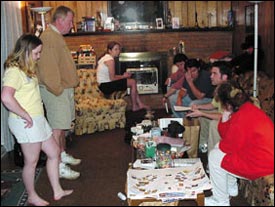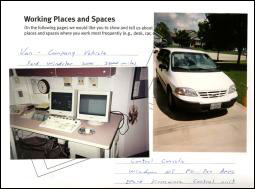Experience design and user experience have become overused, often confusing buzzwords. Regardless of their meaning, most of the people we talk to believe that the desired end result is an emotional connection between a person and her experience with a product or service. When a company is able to make them, such connections can have a positive impact on the profitability and sustainability of the company’s brand.
![]()
| Unlike other approaches to understanding users, participatory design assumes that users should play an active role in the creative process. |
In attempts to make these connections, “touch points,” or areas where people come in contact with a brand, are typically identified and designed. In experience design, these touch points are not bound by a single design discipline, and the interactions between various touch points are critical in making the desired emotional connection. For example, in the area of retail, customers can shop online, through a catalogue, at a store, or over the phone. Most people tend to use a combination of these approaches. They will first learn about a given category, formulate their requirements, and then find the best deal. Each interaction is a touch point that shapes the user’s overall experience.
Picking the right touch point combinations
In order to exhaustively identify the right touch points, new tools for idea generation, such as scenarios and personas, have emerged. In most cases, these tools tend to be based upon the cognitive or functional elements of what users want or need. The tools can be generated either by brainstorming or through research ranging from quantitative to ethnographic. These tools can help put a human face on users and unite a design team behind a common goal.
While these tools can be very useful to an interdisciplinary team, they are only as good as the beliefs and assumptions upon which they are founded. We have heard about numerous design processes and approaches for making emotional connections, yet many of these approaches were founded upon assumptions that proved to be incorrect. For example, brainstorming user or customer needs can lead to unvalidated assumptions about users. When based upon limited information or faulty assumptions, tools can focus a design team—and ultimately a business—on an objective that does not result in an emotional connection.
To increase the probability of making an emotional connection, and to identify opportunities to make such a connection, better information is needed at the fuzzy front end of the design process. Ideally, the people who bring alive a business’s various touch points (the cashiers in the store or the interaction designers, for example) need to understand what users want and how they want to feel. To do this, they need to gain access to the dreams and imaginations of the target users. If they are successful, a company can begin to see its future through the eyes of the people who will pay for its products or services. This information is often difficult to obtain from just talking to people or observing their behavior, and these difficulties have led to the misconception that people do not know what they want or cannot tell you what they want. We believe, though, that people have a latent sense of what they want, which may not be easily expressed through conversations or interviews.
Participatory design has emerged as a response to these difficulties. Unlike other approaches to understanding users, participatory design assumes that users should play an active role in the creative process: users envision the future by identifying the defining moments from their perspective. These moments can highlight critical touch points and the desired feelings associated with them, which serve as a foundation for emotional connections.
Through years of efforts to understand people and their experiences, we have come to believe that:
- All people are creative.
- All people have dreams.
- People project their needs onto ambiguous stimuli.
- People are driven to make meaning and will fill in what is unsaid or unseen.
From these principles, we have learned to create exercises that merge psychology, market research, and design. These exercises place the tools for ideation directly in the hands of the target users and enable them to express their desired experiences.
Using participatory design techniques
- To offer suggestions for creating participatory design exercises, we will discuss three main areas:
- the tools for the exercises,
- the exercises, and
- the ordering and combining of exercises based upon your project objectives.
These exercises can be executed with groups or individuals where they work, live, and play, or in research facilities.
 |
 |
|
| Focus group respondents doing exercises within a lab environment. | Participatory design exercises being conducted within the “family room.” |
Tools for participatory design techniques
The tools for participatory design exercises resemble items in an elementary school classroom and can be purchased at office, craft, or teacher supply stores. Scissors, glue sticks, poster boards, scrap book pages, stickers or printouts with words or pictures, cameras, playful shapes, and markers are typical items. Stickers or printouts with words or images are especially useful because they can used to express items, feelings, actions, features, etc. For three-dimensional or interactive products, Legos or building blocks may be used.
Exercises can be developed to express cognitive, emotional, aspirational, and procedural issues. They can also be developed to enable the embodiment of ideas. In creating the exercise, both the choice of words and images and instructions for the exercise must be considered.
Emotional exercises tend to ask people to describe an experience and use words that describe feelings: careful, alert, relaxed, etc. The images are tend to show people expressing emotion or elements which tend to drive elicit these emotions.
Procedural exercises usually involve asking a person to describe a current or aspired process. They use action or activity words, such as: think, create, shop, buy, etc. The images are typically cartoon-type drawings that express actions or items associated with these actions.
The act of laying out the words and images and the choice of placement on the paper or poster board enable participants to map out much more than could be kept in their conscious memory during a conversation. They also give the participants a chance to notice and articulate their latent feelings. Participants often mention that the act is fun and therapeutic.
The “path of expression”
In experimenting with many of these exercises, we have discovered an approach that involves asking users to imagine the future of a business based upon their needs and aspirations. What follows is a preliminary explanation of what we have learned. We call this the “path of expression.”
![]()
The first step is to get research participants immersed in and aware of their daily experiences surrounding the area of focus. This brings latent daily experiences into their conscious memory. A variety of self-documentation exercises can be applied, such as scrapbooks or storytelling exercises.
After becoming aware of her experiences relative to given subject, a person is ready to express associated emotions. In this step, the participant begins to articulate her feelings and the causes of those emotions to herself and then to the research or design team. We tend to use emotive words and images in a collage.
Asking participants to dream about an ideal or aspired experience is the next step in the process. It is often a good idea to get people to think about how the experience should feel in abstract terms. Collages are a useful tool at this point, as are maps of processes or events. In most cases, these contain both cognitive and emotional elements. Collages can also be used to ask participants to describe an experience over time or to contrast a current experience to an aspired one.
After getting participants to imagine how they want to feel, they are prepared to create solutions that will provide their aspired experiences. The opportunities for exercises at this point can range from mapping a process or event to embodying an interface, information architecture, or product.
Identifying key moments and emotions
The results of these activities are ideas from the imagination and aspirations of the target users. Their ideas are usually unbiased by competitive, technical or manufacturing constraints or by industry expertise. By identifying the key moments in their desired experiences, emotions associated with those moments, and the specific components that can provide these feelings, a foundation for applying the processes of experience design is established. The team can begin to focus their creativity and expertise to design for the desired experience. Opportunities to make an emotional connection become clear, actionable, and inspirational.
These opportunities may be uncovered during the actual research process, but in many cases, the resulting data, information, and artifacts need to be thoroughly and rigorously analyzed to find patterns and themes. We have explored and continue to explore approaches for analysis; however, the issue is too broad to be discussed within this article. We do know, though, that there is no substitute for the design team hearing and seeing firsthand the ideas generated from the imaginations of the people whom their creativity will ultimately serve.














Participatory Design or Participatory Discovery? I’m digging the article, and think it’s a great improvement over traditional focus groups. But I still see it as expressing preferences…in this technique how do we ground preference to *goals* (since the two don’t always correlate). Also, how do we take the need expressed in a participant’s suggested design and separate it from the “embodiment of the ideal”, where said user-designed embodiment may not be ideal?
When I use this concept I think I might call it “Participatory Discovery” so that the chance of management thinking designers aren’t needed anymore is lessened (think “hey, the users can design everything”).
Jess,
Good point about the title. We usually call what we do “Participatory Design Research” as we do not believe that users are designers. We do believe that users are creative and can express their dreams when we give them a chance to do so.
Liz
Hey Liz,
I didn’t think that you really intended this technique to produce “final design” – I am concerned about ‘participatory design’ as a lable in general (and recently posted to CHI-WEB trolling for discussion on if participatory design is really design). Maybe you could weigh in there as well?
I have recently been active in a participatory design study, we used the results from this study to drive our design, we looked for patterns and built upon those. It’s been a wonderful, conducive experience. It has driven the structure of the site for the most part.
Great article! I’d like to hear more about projects that used participatory design for other things (aside from getting a better understanding of your users, has anyone used this to pin down requirements or design a UI?)
I am about to commence an exploration of “design by users” approach for first-time users of mobile telephones in rural India. I find this article very useful and one of the few that actually asserts the belief that people are creative and can become key drivers of new innovation. This contradicts the widely-held belief that users don’t know what they really need or want – it is (only) the designer who has this insight/ability. Of course, the challenge lies in designing the tools & techniques to involve and enable the users to design in such a way that it dovetails into the conventional corporate R&D processes. I would welcome any suggestions or references in this regard: email me at lodaya_at_gmail.com please. Big thanks to Marty and Preetham for flagging this important and unattended opportunity.